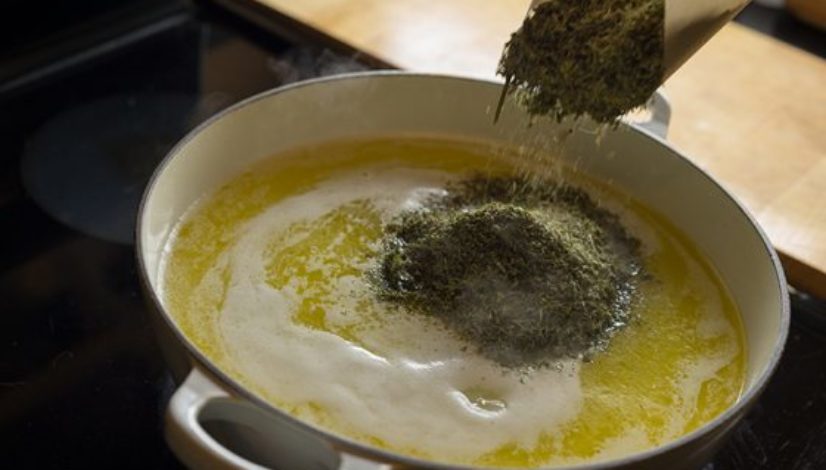How to safely try cannabutter or cannabis oil when you don’t know its THC potency

Published: Oct 25, 2017, 7:43 pm • Updated: Oct 25, 2017, 7:44 pm
By Susan Squibb, The Cannabist Staff
Hey, Cannabist!
I’m thoroughly confused. A cannabis grower relative gave me a jar of green cannabis oil, I expect made with coconut oil. I have no idea how to use it! No idea of its potency or THC level and cannot reach him by phone or text. What do I do to “test” this stuff? Do I melt some of it in a skillet and put a tiny bit on a cracker? Do I make brownies? I’ve looked for answers on Google and all I get are directions on how to make the cannabis oil, no real suggestions as to how to ingest it when one doesn’t know potency. I’m 77, and don’t want an overreaction. Thanks. — Senior Newbie
Hey, Senior Newbie!
Great Scott! How rude of him to not return your calls or texts. Let’s sort this out with some advice from experts on how to handle marijuana-infused oil or cannabutter with unknown THC potency.
I consulted with two longtime edibles experts: Elise McDonough, a Santa Cruz, California-based marijuana writer who specializes in cooking and edibles, and Martha Montemayor, director of Cannabis Clinicians Colorado. McDonough, author of “The Official High Times Cannabis Cookbook,” has a decade of experience cooking with cannabis, deciphering mystery marijuana infusions and sampling edibles across the globe. Montemayor is a certified nutritional consultant and has assisted many first-time medical marijuana patients at Healthy Choices Unlimited.
Some unsuspecting people have become overwhelmed after consuming potent edibles.
“The psychoactive effects of edibles are less predictable than they are with other forms of cannabis,” Montemayor says via email, adding that the effects can also last longer compared with smoking or vaping. “As with alcohol, THC tends to have a more profound psychoactive effect on women and older adults.”
Montemayor says the onset time for edibles is typically between 30-90 minutes, and the rate of THC uptake via digestion varies. The effects of edibles can have a duration of up to eight hours, possibly longer. Therefore, it’s important to be cautious.
Proceed slowly and start with a small portion size. Here are some tips:
Before you start sampling your batch of cannabis oil, homogenize it to ensure THC is distributed evenly. Heat all of the oil at a low temperature, just warm enough to liquefy it. Gently, but thoroughly, stir until it’s completely blended. Let cool in a clean, dry, freezer-safe container. McDonough suggests freezing the oil in an ice cube tray and then storing the oil cubes in a clearly-labeled plastic bag in the freezer. This is a handy way to divide the oil into smaller portions and ensure it keeps for a longer period.
The next step is determining when and where to carry out your experiments. You’re likely most comfortable at home. Have a loose plan of what you’ll do in the hours after ingesting the canna-oil.
If you want to do your experimenting during the day, don’t drive a car or decide to run errands or tackle a complicated maintenance or cleaning project. McDonough recommends cultivating a mellow setting to help you have the calmest experience possible. Perhaps reading a book or working on your favorite hobby or handicraft would be an enjoyable way to pass the time.
Montemayor suggests a different approach. “Many people rely on a nightly dose of edible to help with insomnia, chronic pain, and other issues. It’s best to experiment with edibles before bedtime. Nobody cares if you are stoned in your sleep.”
Day or night, keep your schedule and activities simple.
Related stories
- Man who caused fracas when he tried to open plane door had consumed edible
- Six things to know about Nevada marijuana: edibles, tourism impact, casino ban and more
- How to safely try marijuana edibles: A guide for beginners
To begin the testing, McDonough recommends: “Start with the smallest amount of oil possible, just 1/8 of a teaspoon. Ingest it in a small glass of hot tea with milk and honey (or go plain if you prefer). McDonough says the extra fat in the milk and the sugars in honey or other sweeteners are believed to aid the absorption of THC and hasten the onset time.
Wait two hours and see if any effects are felt. If nothing happens, try again the next day. Increase the amount to 1/4 teaspoon and see if any different effects are felt after two hours. If you do not feel anything after a couple hours, take heed of McDonough’s advice and try again the next day. Don’t consume any more infused oil.
Many people fall into a situation where they don’t feel anything at first, then they eat a larger portion. When it does kick in, they end up feeling really stoned, disoriented or uncomfortable. By pacing the experiments to one a day, you’ll avoid this common compounded mistake.
Montemayor advises keeping a personal log to track your dosage and experience. Write down the serving size, and how you feel after one hour, after two hours or however long you perceive the effects.
Each time you try, continue to incrementally increase the amount consumed until the “minimum effective dose” is discovered.
Even with this slow-and-gradual approach, it is helpful to have a few simple remedies on hand if you feel out of sorts after drinking your infused tea. McDonough’s suggested home remedies include inhaling the smell of fresh peppercorns, which seems to help some people, drink water or juice and take a nap.
“If you feel panic or anxiety, try to maintain a peaceful and calm mood,” McDonough says.
Home remedies from Montemayor include drinking plenty of water, lying down in a safe, comfortable place, and reminding yourself, “No one has ever died of an overdose of marijuana alone.”
But what if you don’t feel anything at all? If you’ve repeated the daily experiment with increased serving sizes and consistently don’t notice any effects, this particular jar of gifted cannabis oil might not be very potent. Whenever you try a new batch of oil, or a new or different brand of commercially-made edibles, always take the cautious approach.
Store-bought edibles: Eight tips for getting the right dose
Additionally, you might not experience anything because eating marijuana simply may not be effective for you. Montemayor says: “Just as one in five people do not respond to narcotic pain killers, one in five people have only a minimal effect from edibles. If you’ve been slowly increasing the dose … with no effect, you may be a non-responder to edibles.”
If this is your experience, other methods for consuming THC are available. Non-smoking options such as vaping or topicals might be more effective for you.
Even though you don’t directly mention the reasons you want to try marijuana, I assume you might be looking for medical or therapeutic benefits. Your doctor likely won’t know how to advise you on dosage or experiments for your infused oil. Nevertheless, it’s a good idea to discuss this and be forthright with your doctor or trusted medical professional. For your research, the Mayo Clinic has some dosing guidelines for certain medical conditions, and there’s additional information for patients at the Society of Cannabis Clinicians and Drugs.com. Best wishes! XO
Ask The Cannabist: Clearly you have questions about marijuana, be it a legal concern, a health curiosity or something more far-reaching. Email your queries to [email protected].
Watch: Info for medical cannabis patients from Healthy Choices Unlimited
Home cooking: We’ve got our weed recipes sorted,
appetizers || entrees || desserts
Topics: cannabis oils, cannabutter, cooking with cannabis, edibles, edibles advice, edibles safety, thc, thc content in edibles  Susan Squibb
Susan Squibb
Susan Squibb, the Cannabis Maven, is a Denver-based freelance cannabis writer and an operations management consultant. She founded and organizes the event, Mother’s High Tea. Connect with her on LinkedIn, Twitter and…




